#enryakuji
Explore tagged Tumblr posts
Photo

Japanese Monasteries Unveiled
Life in Japanese Buddhist monasteries is steeped in a rich history that dates back to the 7th century CE. These monasteries were not only pivotal institutions in Japanese society but also produced some of the country's most exquisite works of art, from paintings to intricate sculptures. Today, many of these ancient temple complexes are recognized as UNESCO World Heritage Sites.
Key Facts
Established in the 7th century CE: Buddhist monasteries have been integral to Japanese culture for over 1,300 years.
Social Role: Monks served both the spiritual and local communities, contributing to enlightenment and community service.
Artistic Contributions: Produced renowned works of art in painting, sculpture, and calligraphy.
Historical Context
Buddhist monasteries in Japan flourished during the medieval period, playing a significant role in preserving ancient traditions and contributing to the country's architectural heritage. The influence of these monasteries extended beyond spirituality, shaping artistic and social practices.
Historical Significance
The historical significance of Japanese Buddhist monasteries lies in their enduring impact on the nation's architecture, art, and religious culture. Many of these monasteries remain today as symbols of Japan's rich cultural history, attracting visitors from around the world.
Learn More: Life in a Japanese Buddhist Monastery
#HistoryFacts#History#Yakushiji#Todaiji#To-ji#Sanjusangendo#Ryoanji#PrinceShotoku#MountKoya#MedievalJapan#Mandala#Kofukuji#Kiyomizu-dera#Kinkakuji#Horyuji#Ginkakuji#Enryakuji#Daigoji#Byodo-in#Buddhism#WHE
29 notes
·
View notes
Text

Monks from Enryakuji Temple (延暦寺) on Mount Hiei assisting with rites for the prevention of illness at Kitano Tenmangū Shrine (北野天満宮) in Kyoto in early September 2024
Monjes del templo Enryakuji (延暦寺) en el monte Hiei ayudando con ritos para la prevención de enfermedades en el santuario Kitano Tenmangū (北野天満宮) en Kioto a principios de septiembre de 2024
Image from the temple's official twitter account
#japanese religion#religión japonesa#京都#kyoto#kioto#北野天満宮#kitano tenmangu#延暦寺#enryakuji#buddhist monk#monje budista#巫女#miko#shrine maiden#doncella del santuario
23 notes
·
View notes
Text
In “defense” of the Enryakuji invasion
This is the clash of two military and political powers that finally came to a head, not a one-sided oppression
When people cite the invasion of Enryakuji to accuse Nobunaga of all sorts of horrible things, it’s usually because they were under the impression that an unreasonably large number of people were killed, or that it was an oppressive massacre against a community that weren’t posing a threat.
It’s very unfortunate that it’s very rarely clearly explained to the general public that Enryakuji has armed forces. In a lot of ways it’s almost functioning like a samurai lord’s castle, inhabited by both warriors and civilians alike. They also had massive political power and influence. They’re not a quiet little temple whose inhabitants were peaceful or helpless.
The warrior monks of Enryakuji themselves have committed massacres and invasions. They do not accept other sects rivalling them, either out of genuine religious zealotry and considering the other sects “heretics”, or because they simply want to maintain their sect’s influence and authority in Kyoto. They were not politically neutral, nor were they pacifists.

(A Cultural History of Japanese Buddhism, page 178)
I emphasise the part where it says the Enryakuji warriors wrecked Kyoto so badly, it’s equal to -- or even worse than -- the destruction in Kyoto when the Onin War broke out. These monks are vicious and violent.
They were still meddling in politics and battle in Nobunaga’s time. During Nobunaga’s battles with the Azai and Asakura, these monks joined in the forces opposing Nobunaga. They took part in besieging Usayama Castle, which resulted in the death of one of Nobunaga’s brothers and some other senior vassals.
The killing of thousands of combatants and civilians alike regularly happens when any one lord invades another territory. There are no stipulations to spare civilians. If a lord decided to evacuate civilians first before the invasion, then it is a benevolent act. Otherwise, civilian casualties is just a fact of life in that time period.
In which case, how is Nobunaga’s invasion any different than, say, the occasion where Nobunaga invaded Mino and conquered the Saitou? That's rarely, if ever at all, cited that as an example of cruelty. That was just a battle.
There is no reason to be especially horrified about this Enryakuji incident above any other battle or invasion. This is nothing about this battle that more morally outrageous than what every samurai commander regularly do when engaging another samurai in battle.
I would grant that many people may think that any mass-death is automatically horrible, and perhaps no amount of reasoning and justification can make the Hieizan invasion and burning defensible. There is no denying that thousands of people were killed in Enryakuji. It’s fine if one were to still condemn this even after knowing the circumstances. Still, knowing and understanding the context matters.
The Hieizan situation only looks different than a regular castle invasion because Enryakuji has the facade and still does operate as a temple. There is something about religious sites that inherently invokes the image of sacredness after all, regardless of the faith, and the general public tends to view them differently than a regular fortress or castle.
It is true that there were contemporary Sengoku writers who severely criticised Nobunaga for his actions. However, for the Japanese at the time, Enryakuji is a holy site with immensely deep cultural and spiritual significance. Not just the temple, but the whole mountain itself. No matter how justified Nobunaga was, or even if nobody was killed, people were going to be up in arms about it simply for the fact that Hieizan was targeted.
Think of the time when the Notre Dame caught on fire. People from all over the world were horrified. Imagine how much worse would it be if, say, there’s a fire in the Vatican. That’s what it was like for the people there at the time.
On top of that, the chief priest of Enryakuji also happens to be the emperor’s brother. This invasion can be perceived to be disrespectful to the imperial court. It only worsens the uproar surrounding this situation, which then supposedly led to the dramatic letter where Nobunaga calls himself the Dairokuten Maou in a spiteful reply to Shingen’s letter rebuking him in the name of the chief priest.
An additional point in the “defense” is the numbers. For some reason there is a claim that 20 thousand were killed in the Enryakuji invasion. I have yet to find the exact source of this information. Wikipedia and other online articles cite Stephen Turnbull’s book, but I cannot find corroboration for this claim in the original historical documents.
Shinchoukouki said "many thousands” and did not specify a number, and Luis Frois recorded that he was told around 3000 were killed (about 1500 combatants, and 1500 civilians).
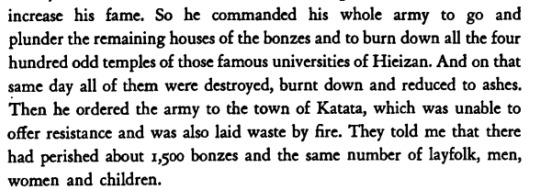
(They Came to Japan: An Anthology of European Reports on Japan, 1543-1640, page 99)
The claim of 20 thousand people killed also does not make sense as, supposedly, there weren’t even 10 thousand people inhabiting the Enryakuji complex in Hieizan at the time. How can the dead amount to more than double the actual number of inhabitants?
Lastly, there’s also reports from on-site research that claims that, as of 1980s, they weren’t able to find “proof” of massacre or mass-burning. They have yet to find the human remains of the dead, nor expansive traces of burning in the soil. The burning traces that was discovered were very minimal, compared to the narrative of “the whole mountain was up in flames”. On top of that, there were existing textual records describing many of the buildings were already dilapidated and abandoned as of 1570, and so even if they were burnt, there were no casualty or major losses.
However, this is a decades old report and I haven’t seen any certified updates on this yet. To be able to make a definitive claim, they would have to conduct a scan of the whole mountain, which is difficult to do.
#japanese history#enryakuji#enryaku-ji#hieizan#hiei-zan#mount hiei#mt hiei#oda nobunaga#sengoku#Sengoku period#Sengoku Era#Warring states#Warring States Era#Warring States Period#nobunaga oda#samurai
16 notes
·
View notes
Text
Day 12 Enryakuji
Finally, reached the top of the mountain and the temple!! Welcome to Enryakuji.


The temple grounds were a lot bigger than I initially expected, meaning I didn't really have time to give everything a proper look before having to go down again. I mostly regret not realizing there was some kind of collaboration going on with Violet Evergarden at the Garden museum until the moment I sat down in the cable car. Would have loved to see what that was about.
So, all I had a look at was the main area and one of the side areas. On my own though. When I arrived at the top, my husband announced he was going back down again. Apparently the cable car had done his fear of heights no good and the idea he had to ride it again stressed him out so much he wanted to get it over with as soon as possible.
So, I started exploring by myself.

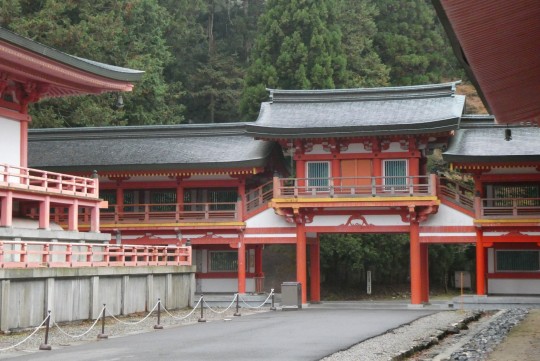

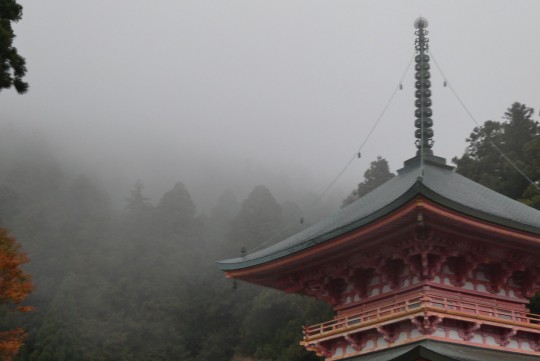
It was a bit unfortunate that the main building of the whole place was being renovated and barely visible to the eye. Seems it is going to take a few more years before they are done. But I suppose everything else was really pretty. Some parts were newer looking than others.
The oldest were probably located in one of the side parts I decided to visit, which was a roughly ten minutes walk away from the main area. Even though my husband was already asking me to hurry up and catch a cable car, since he was getting antsy about reaching Tokyo too late. (Any time before midnight is still on time! It's only 4PM! Let me explore!)
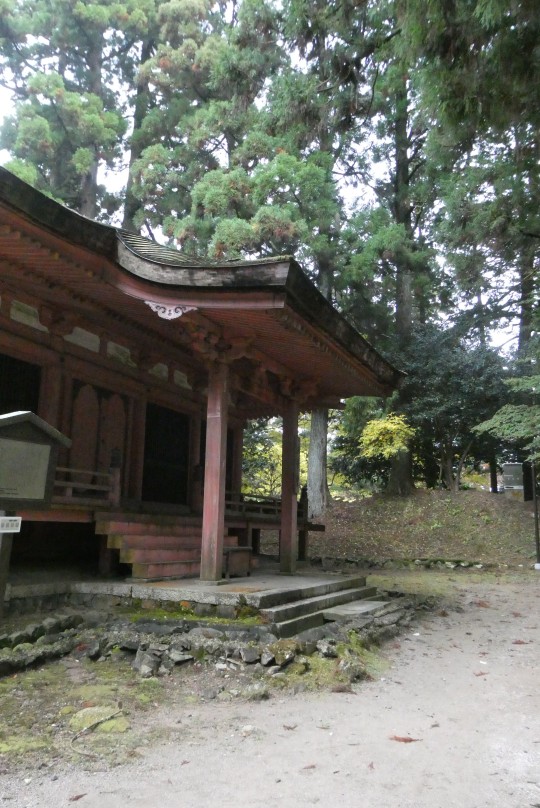
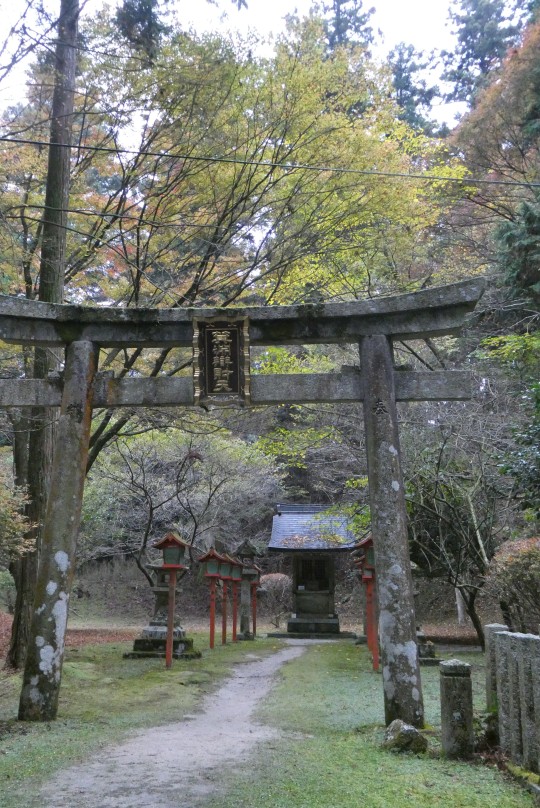

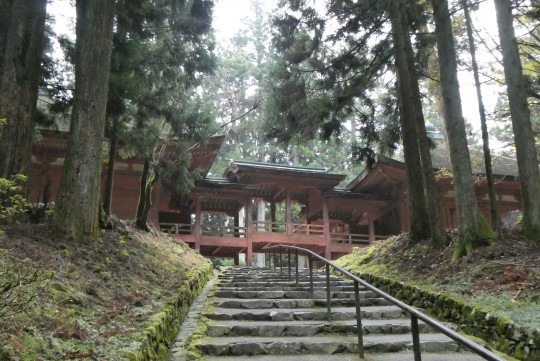
After a quick look around, and with my husband getting impatient, I ended up rushing back to catch the cable car that would leave half past four. In the end it was a bit further away than I initially expected, but I did make it in time and I got to sit down for the trip.
The ride was nice, apparently it's the longest cable car ride in Japan? But I suppose I do prefer walking up and down a mountain by myself. This time, that was unfortunately impossible.
By the time I reached the bottom, my husband was already at the JR station, telling me I had exactly 18 minutes to make it to the station, or we'd have to wait for the next train. Now guess how long it takes to walk to that station according to google? You guessed it, 18 minutes.
So, walking on full speed, I made it to the station with just 2 minutes to spare!
In Kyoto we grabbed some food at the convenience store, released our suitcases from the locker and sat down in a Shinkansen to Tokyo before eating out very lavish dinner consisting of nikuman and pizzaman.
And thus concluded my birthday...
Ah, no... In Tokyo we still had to find our hotel and my husband very carefully guided us to the wrong one. Like, in what world would a hotel chain need two hotels almost right next to each other? And give them almost exactly the same name? Who would think of that!?
Anyway, paying for a room with a view was definitely worth it! (Photos will follow later, I already reached my 10 photo allowance for this post...)
2 notes
·
View notes
Photo

Empereur Kammu
L'empereur Kammu (alias Kanmu) régna dans l'ancien Japon de 781 à 806 et est surtout connu pour avoir déplacé la capitale à Heian-kyō (Kyoto) en 794. Kammu était l'un des empereurs les plus puissants que le Japon ait connu ou connaîtrait jamais, et son règne fut marqué par une restructuration de la maison royale et du gouvernement, réduisant les coûts de l'État et le rendant plus apte à gérer le pays et à lutter contre la corruption.
Lire la suite...
#Histoire#Saicho#Nara#Kiyomizu-dera#Heiankyo#PériodeHeian#Enryakuji#EmpereurDuJapon#EmpereurKammu#Kyoto
0 notes
Text
ヒエイザンエンリャクジ

比叡山延暦寺は、滋賀県大津市にある日本仏教の聖地として知られる古刹です。788年に最澄によって開かれ、天台宗の総本山となりました。比叡山の広大な山域に多くの堂塔が点在し、根本中堂や大講堂、横川中堂などの重要な建造物が知られています。延暦寺は、日本仏教の重要な拠点として、多くの高僧を輩出し、日本の宗教や文化に大きな影響を与えてきました。また、厳しい修行で知られる「千日回峰行」が行われることでも有名です。比叡山は世界文化遺産に登録されており、歴史的価値の高い建築物や美術品、貴重な歴史的文書などが数多く残されています。自然豊かな環境の中、歴史と信仰の深さを感じられる場所として、多くの参拝者や観光客が訪れています。
手抜きイラスト集
#比叡山延暦寺#Enryakuji Temple#Mount Hiei#Tempio del monte Hiei Enryakuji#Monte Templo Hiei Enryakuji#Berg Hiei Enryakuji-Tempel#Temple Enryakuji du mont Hiei#手抜きイラスト#Japonais#bearbench#art#artwork#illustration#painting
1 note
·
View note
Text
Kyoto 1 day Tour, Rabbit shrine Okazaki shrine with cute rabbit dolls, Hieizan enryakuji temple UNESCO WORLD HERITAGE SITE, Housenin temple, Jakkouin temple, enjoy autumn foliage fully!!
1 note
·
View note
Text
Chapter 3: The History of Hie Shrine
Festivals and Fights
The one possibility for shrines like Hie to pursue their own distinctive path amidst the uniformity of Meiji was the annual festival… end of 1872, the Meiji government legislated a distinction between shrine rites. ㊸ “State rites��� (kansai)… funded by the government… but “private rites” (shisai) would receive neither funding nor patronage… in the case of Hie’s Sannō festival… government funded the offerings made to Ōyamakui on the morning of the third festival day… the rest… were all redfined now as “private…” lest “private” be interpreted as a license for merrymaking… in 1873 ordered mikoshi processions everywhere to exercise restraint and avoid “being rough, bumping into houses or impeding passersby” (Miyachi 1988: 457).
—Page 119
㊸ From the end notes: “This applied only to shrines which, like Hie, were underwritten by government in any way at all. From the early 1970s, only some 139 major shrines out of a national network numbering well over 100,000 were so funded. Ise and Yasukuni, the new shrine for the war dead, were treated as special cases and never wanted for funds.
The discovery and enshrinement of the kami Ōyamakui… displaced the pre-Meiji interpretation… For [Shōgenji] Yukimaru, the descent of the mountain by the two mikoshi-borne kami… the departure of the seven mikoshi from the Ōmiya compound, were… joyous moments marking the entrance of the kami into the human world… akin to Amaterasu’s stepping out of the heavenly cave, restoring light to the word (ST Hie: 161-85). The passage of the seven mikoshi under the three torii gates of Hie…represented the essential oneness of the kami and the buddhas (ST Hie: 315-78)…. Never doubted the truth of Tendai claims about the Buddhist nature of all kami.
…modern Shinto-style Sannō festival yielded a different order of interpretation… “the festival, which is of the greatest antiquity, serves to recreate the birth and subsequent ascent to heaven of [the divine child] Wakamiya.”
—Pages 119-120
The Shrine and its Festival in the Twentieth Century
…The first two decades of the twentieth century saw Hie and other shrines acquire a status in national life higher than at any time since the Restoration… In 1915… priests obtained Home Ministry permission and restored the triangular structure to the top of the main torii gates… in 1928… the Home Ministry ordered that Hie end its ritual subordination of Ōnamuchi to Ōyamakui. The kami were to be regarded as equal, and their equality was to be manifest in new referents for their shrines: Ōyamakui’s shrine was to be known as Nishi Hongū, and Ōnamuchi’s as Higashi Hongū… Western and Eastern Main Shrines respectively. An Imperial emissary attended the Sannō festival in 1929 to present his own offerings to Ōnamuchi, and thus mark the restoration of that Kami’s status. If there was after all no status distinction between the two kami, there could no longer be any justification for the reordering of Hie’s ritual space which Nishikawa had effected back in the 1870s… This is the situation that prevails today: Hie is imagined as comprising western and eastern compounds, each dominated by two great kami whose divine virtues are in every measure equal.
—Pages 123-124
…One striking development of these years was a thawing in the relationship between the shrine priests and the ones of Mount Hiei. In 1837… celebrated the 1,550th anniversary of Saichō’s founding of the Enryakuji temple…. Monk called Umetani, descended the mountain and gave thanks to Ōnamuchi after the festival of that year was over… extraordinary moment… first time in 70 years since the Restoration that a Buddhist monk had prayed before the Hie kami… 1938 a party of monks attended the Sannō festival… received a ritual purification… made offerings to Ōnamuchi before paying their respects to each of the Hie kami in turn… mark the establishment of a new “civility” in shrine-temple relations. It is a civility that endures to the present day, for Tendai monks now participate every year in the Sannō festival in April, and they return to the shrine on May 26 to recite the Lotus sutra before the kami Ōnamuchi.
—Pages 124-125
The Challenge of the Postwar Years
…The Occupation dismantled “state Shinto…” Severing the links between the state and Shinto shrines like Hie was essential to this task… 1947 Constitution duly accommodated….separation of state and religion… vast majority of shrines, Hie sough security amid the new uncertainties by singing up to the National Association of Shrines (NAS)… under the name of Hiyoshi Tanisha, Hiyoshi being an alternative reading of the characters “Hie”; Tanisha or “great shrine” in deference to its elite status in imperial Japan. NAS was launched by prewar Shinto intellectuals and bureaucrats, precisely to prevent the demise of shrines without which Shinto had no meaning.
—Page 125
These two men [Takenami & Murata]] detested one another, largely it seems because they had graduated from rival Shinto universities. 55
–Page 126 55 From the end notes: The two (rival) universities that train men and women for the Shinto priesthood are Kokugakuin in Tokyo and Kōgakkan in Ise. Shrines have a tendency to recruit from either one of these two universities, rather than mixing candidates from both.
….What blocked the “divorce” [Hiyoshi Taisha leaving NAS] was not the prefecture, but NAS’s swift dispatch of a replacement for Sugimura, as well as a campaign by Hiyoshi parishioners… petititioners accused Sugimura of destroying hundreds of trees in protected woodland… discriminating against Hagiyama villagers [historically a burakumin region]. Sugimura was dismissed… but this was not the end of the matter. Seven priests resigned in protest in 1989 at further NAS interference in shrine personnel matters. In the 1990s, tensions of a quite different sort surfaced when a junior priest set upon the chief priest with a metal pipe. At the start of the twenty-first century, harmony has been restored to the shrine and the shrine’s relationship to NAS, or so it seems.
—Page 127
I’m mostly floored at that metal pipe comment, the worst part is he doesn’t expand on it… like WHAT DO YOU MEAN???? THEy ATTACKED THEM WITH A METAL PIPE????
Priests themselves play a vital role in generating income… through their performance of specially commissioned rites… For example… requesting prayers and offerings… for the bestowal of three such “benefits” — family health, safe birth and exam success, say — will pay 30,000 yen. 57 Fees for Shinto wedding rites start at 50,000 yen while ground-breaking rites and assorted purifications can be as much as 70,000 yen a time.
—Pages 128-129
57 From the End Notes: “At the time of writing, 10,000 yen is approximately $US 105.
The costs nowadays is: 30,000 yen ≈ $US199, 50,000 yen ≈ $US332, and 70,000 yen ≈$US465
And with that I finish chapter 3 finally! The next chapter discusses the Ise Shrines, so look forward to that!
3 notes
·
View notes
Text
[Ikesen Historivia] Ikko-ikki

Probably already mentioned this in my previous posts, but even if they come from multiple temples, they’re all from the “Honganji denomination/sect”.
Ishiyama Honganji is the main HQ. They have branch/affiliate temples, and those branches naturally aren’t all called “Honganji”. The monks and the people who go to these temples might be inspired to go out and join the fight as part of the Ikko-ikki, but there’s of course the casual temple-worshippers and faithful Buddhists who don’t wat to fight.
Still, Kennyo is the leader of all the Honganji-affiliated temples and sub-temples. He could tell the Ikko in some other province to riot without him needing to be there, and they would go out and riot (as Shingen once referenced in the game).

So it’s not like the Ikko-ikki are, say, Honganji and Enryakuji working together. Those are two different Buddhists sects (who hate each other).
There’s enough affiliate Honganji temples for there to be a huge Ikko army to overthrow the samurai lords of an entire province.
Though, I’m talking about the historical fact here, and I’m honestly not sure what the Ikesen writer thought the Ikko-ikki was like. I went out of my way to poke around to figure out this mess of temples, but before that I also had all these groups mixed up too.
6 notes
·
View notes
Text

Recientemente, @mitosjpenespanol viajó a Japón. Conoce historias y lugares maravillosos que me encontré durante mi travesía por la tierra del sol naciente.
El santuario de Ushijima
En el borde del gran río Sumida, cerca del puente Kototoi, se yergue un hermoso santuario de tejas verdes y doradas. Sobreviviente de muchos fenómenos naturales, se dice que este templo fue construido en el año 860 por el sacerdote budista Ennin. Nacido en la prefectura de Tochigi, viajó a China como parte de la comitiva diplomática del político Fujiwara no Tsunetsugu. Posteriomente, profundizó allí en las prácticas budistas hasta ser deportado a Japón debido a las políticas antibudistas del emperador Wuzong. Ya en el país, Ennin se dedicó a la expansión del budismo de la escuela Tendai por medio de la ampliación del complejo monástico de Enryakuji.
Sobre el origen de Ushijima, se cuenta que Ennin salió de excursión rumbo a Senso - ji, templo principal de Tokio. De camino a este, un anciano lo abordó y le pidió que construyera ahí un santuario para proteger a las personas que vivían a orillas del río Sumida. En realidad, aquel anciano era la encarnación del dios Susanoo.

Este dios era el hijo de los dioses primordiales Izanami e Izanagi, su nombre significa “macho impetuoso”. Aunque generalmente es asociado a la calamidad, en realidad, encarna la fuerza de la naturaleza, que para los humanos puede ser tan bondadosa como funesta. Cuando nació, sus padres le dieron los dominios del mar, la tierra y el rayo; por lo que su solicitud de un santuario para proteger a los habitantes de las cercanías del río resultó lógica para Ennin.
La particularidad de este santuario es que está dedicado a tres deidades: Susanoo, Amenohohi y Sadatoki Shinno. Amenohohi es, de hecho, sobrino del primero; fue enviado a la tierra por su madre Amateratsu para gobernar Japón. El tercero fue un príncipe que en el año 929 murió en las cercanías del templo y posteriormente fue deidificado. Debido a esto, este santuario cuenta con una puerta torii especial llamada 'mitsutorii' 三鳥居. El torii es la entrada de los dioses, marca el término del espacio mundando y el inicio del espacio sagrado. Como este santuario está consagrado a tres dioses, debe tener una entrada para cada uno.
Esta puerta es una reconstrucción hecha en el 2019 gracias a las donaciones de los vecinos del río Sumida. Un tifón sucedido en el año anterior destruyó la puerta original. Para la nueva, se utilizó la madera de un ciprés de 170 años de antigüedad. Está elaborada con una técnica tradicional japonesa en la que no se usa ni un solo clavo para unir las piezas.

Su nombre, Ushijima incluye los caracteres 牛, buey o vaca, e 嶋, isla. Se le dio ese nombre debido a que está construido justo en el sitio donde los habitantes de la zona mantenían a sus vacas.
En todo el santuario se hallan varias esculturas de bueyes y vacas, entre las que destaca una en la que recae una bella superstición: si de algo se adolece, se puede tocar esa parte del cuerpo de la escultura de bronce y así la dolencia desaparecerá.


www.mitosjpenespanol.tumblr.com
Lee mitos coreanos aquí.
Lee mitos griegos aquí.
Lee sobre los símbolos del Tarot aquí.
#Ushijima#Sintoísmo#Shinto#Shintoism#religion#Japan#Japón#Nihon#日本#mitología japonesa#mitos en español#mitos y leyendas#japanology#susanoo#ennin#budismo#buddhism
1 note
·
View note
Text
A look into Japanese history Part 5
Oda Nobunaga:
Gained control of Owari province in 1559.
Captured Kyoto in 1568.
Eliminated enemies, including militant Buddhist sects (Ikko sect).
Destroyed Enryakuji monastery in 1571.
Continued fighting the Ikko sect until 1580.
Fortunate deaths of rivals Takeda Shingen and Uesugi Kenshin.
Defeated the Takeda clan at the Battle of Nagashino in 1575 using modern warfare.
Murdered by general Akechi Mitsuhide in 1582.
Toyotomi Hideyoshi:
Defeated Akechi Mitsuhide and took control after Nobunaga's death.
Subdued Northern provinces and Shikoku by 1583.
Conquered Kyushu in 1587.
Defeated the Hojo clan in Odawara in 1590, completing Japan's reunification.
Destroyed many castles to strengthen control.
Conducted the "Sword Hunt" in 1588, confiscating weapons from farmers and religious institutions.
Enforced strict social class distinctions, requiring samurai to live in castle towns.
Started a land survey in 1583 and conducted a census in 1590.
Completed Osaka Castle in 1590.
Issued an edict in 1587 expelling Christian missionaries.
Increased persecution of Christians in 1597, executing 26 Franciscans.
Attempted to conquer China by invading Korea in 1592.
Captured Seoul but was pushed back by Chinese and Korean forces.
Final evacuation from Korea in 1598, the year of his death.
Tokugawa Ieyasu:
Successor of Hideyoshi.
Became the most powerful man in Japan after Hideyoshi's death.
1 note
·
View note
Photo
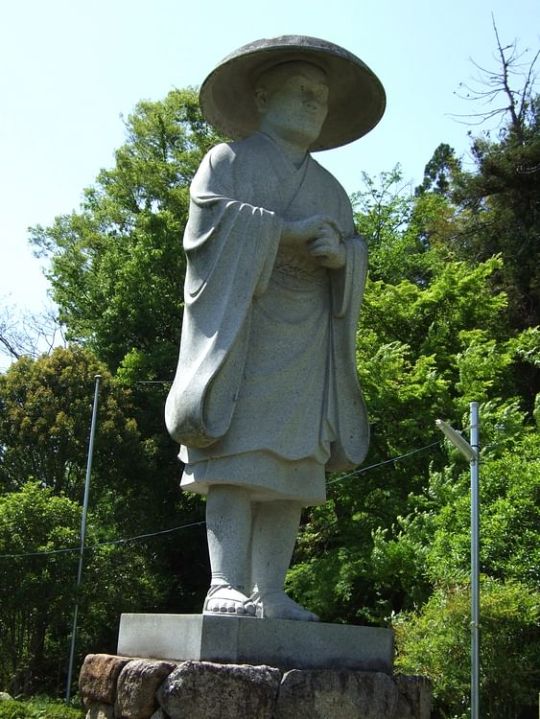
Ennin
Ennin (c. 793-864 CE, posthumous title: Jikaku Daishi) was a Japanese Buddhist monk of the Tendai sect who studied Buddhism at length in China and brought back knowledge of esoteric rituals, sutras, and relics. On his return, he published his celebrated diary Nitto Guho Junrei Gyoki and became the abbot of the important Enryakuji monastery on Mount Hiei near Kyoto and, thus, head of the Tendai sect.
Tendai Buddhism had been introduced to Japan by the monk Saicho, also known as Dengyo Daishi (767-822 CE). Based on the teachings of the Chinese Tiantai Sect, Saicho's simplified and inclusive version of Buddhism grew in popularity, and its headquarters, the Enryakuji complex on Mount Hiei outside the capital Heiankyo (Kyoto), became one of the most important in Japan as well as a celebrated seat of learning. Ennin became a disciple of Saicho from 808 CE when he began to study at the monastery, aged just 14.
Travels to China
Ennin was selected as part of a larger Japanese embassy led by the envoy to the Tang Court, one Fujiwara no Tsunetsugu, to visit China in 838 CE and study there. The main aim was for Ennin to study further the Tendai doctrine at the T'ien-t'ai shan. Ultimately, he would stay there for nine years, studying under various masters and learning in greater depths the tenets and rituals of Buddhism and especially the mysteries of Mikkyo, that is esoteric teachings known only to a very few initiated priests.
On arrival at Yang-chou and awaiting to be taken to T'ien-tai shan, the monk wasted no time and there and then found priests to teach him shitan, the Indic script used in esoteric texts. He also made his own copies of such texts and underwent an initiation with a priest called Ch'uan-yen. As it turned out Ennin did well, for by the time the Chinese authorities had organised his transport to his original destination he was informed there would be no time to do so if he were not to return to Japan as planned with the embassy. Ennin decided to stay and passed the winter at a monastery in Shantung run by Korean monks.
In the spring Ennin set off for Wutai, an important pilgrimage site and home to some more learned monks who could help satiate his thirst for Buddhist knowledge. Mount Wutai, where the bodhisattva Manjusri was thought to have appeared, was also a centre of esoteric cults. Over the next 50 days, Ennin acquired such techniques as rhythmically chanting the name of Amida Buddha and changing the intonation each repetition.
From 840 to 845 CE Ennin then studied at Ch'ang-an, learning more of Mikkyo, copying texts and mandalas, and being initiated by three different esoteric masters, going beyond the level that the recognised Japanese master and foremost expert Kukai had reached. In 845 CE Ennin, like many Chinese monks, suffered the persecution of anti-Buddhist emperor Wu-tsung, and he was compelled to return to Japan. This was easier said than done and it took two years, the death of Wu-tsung, and a general amnesty for him to finally find a ship that would make the voyage.
Continue reading...
29 notes
·
View notes
Text
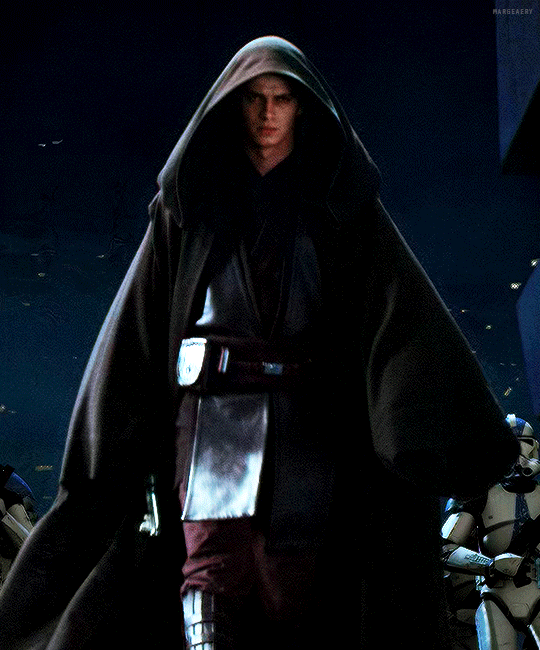

youtube
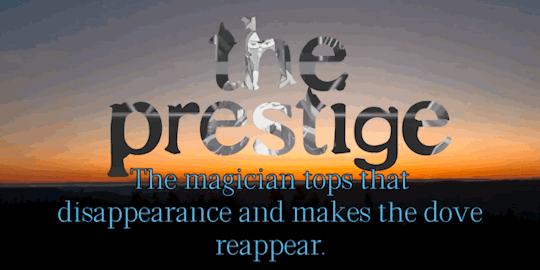
No one ever helped me truly. Shame on you all.
0 notes
Text
Nobunaga and the "Dairokuten Maō faith"
This was described in a tourism website, so it might not be necessarily true. That being said, the article claimed that the reason why Nobunaga called himself the "Dairokuten Maō" was because he might be someone who is a participant of the Dairokuten Maō worship/faith.
To explain this a little: I once mentioned that the Dairokuten Maō is actually worshipped in some areas. There are various possible reasons, but one possible reason is that in non-Buddhist faiths, this "demon king" is viewed as a guardian.
As a demon, the Maō tempts people away from Buddhist enlightenment by worldly possessions. Gold and riches and lustful pleasure. Therefore, if someone doesn't believe in Buddhism, it would make sense for them to think that this is actually a good thing and perceive the Maō as some kind of god of prosperity instead.
Slightly related to the above, there were also some medieval texts linking the Dairokuten Maō to Amaterasu and/or other deities. I'm not sure if this is in any way relevant to the worship of the Maō, but it might be relevant to Nobunaga's actions.
This is a narrative that supposedly came from the Taiheiki (possibly a more modernised translation):
「イザナギ・イザナミの第一の御子神が、「この国の主と成て」伊勢に鎮座したとき、第六天魔王が現れた。魔王は、この日本の国に仏法が広まると力を失うという理由から、天照大神の働きを妨害しようとした。
そこで天照大神は、魔王に「私は仏・法・僧の三宝には近づかない」と誓った。魔王は怒りを鎮め、その血で契約書を書き、天照大神に手渡した。「世界が滅び去るまで天照大神の末裔をこの国の主とする。もし、天皇の命に従わず、国を乱し、人民を苦しめるものがあれば、魔王の眷属が必ず罰を与え、死をもって報いさせよう」
[太平記]
When Izanagi and Izanami's first deity offspring "became the ruler of this land" and settled down in Ise, the Dairokuten Maō appeared. Since he would lose his power if Buddhism spread throughout the land of Japan, the Maō attempted to interfere with Amaterasu Ōmikami's actions.
Therefore Amaterasu Ōmikami swore to the Maō, "I will not come near the Three Treasures of Buddhism; the Buddha, Dharma, and the monks". The Maō's anger was appeased, and he wrote a contract in his blood which he gave to Amaterasu Ōmikami. "Until the world perishes, the descendants of Amaterasu Ōmikami shall be the rulers of this land. Supposing that anyone disobeys the Emperor's order, disturbs the country, or causes suffering to the people, the Maō's kin and house will surely punish them and repay it with death."
Some articles I've seen claim that there are also similar narratives where the ones who made the deal with the Maō were Izanagi and Izanami instead. As they were the creator-gods, this version escalates the Maō's importance even further. Though, I haven't seen any quotes of the actual text of this version yet.
The Taiheiki is a classic that I would expect the samurai lords of Nobunaga's time are familiar with. The idea that Nobunaga called himself the Dairokuten Maō based on the above Taiheiki text would lend some credence to the theories saying that Nobunaga might have been aiming to abolish the shogunate to restore power to the emperor.
As seen above, the Maō proclaims to be the emperor's protector, and also someone who safeguards peace in the nation. Even if Nobunaga doesn't particularly worship the Maō, he might have been inspired to view himself as that "Maō's kin and house" who puts to death those who disturbs the nation in service to the emperor.
Edit: It slipped my mind a little when I was originally writing this, but the argument against this would be that at the time of the Enryakuji burning, the head abbot of the temple was actually the emperor's brother. Nobunaga's attack on Enryakuji can be perceived as slight against the imperial household.
On the other hand, you could also argue that the Maō's protection only extends to the sitting emperor. Therefore, if Nobunaga was acting based on the Maō's promise written in Taiheiki, attacking Enryakuji is not against that principle.
#oda nobunaga#dairokuten maou#dairokuten maoh#demon king of sixth heaven#demon king of the sixth heaven#japanese history#sengoku#sengoku period#sengoku era#samurai#warring states#warring states era#warring states period#theory#feudal japan
15 notes
·
View notes
Photo
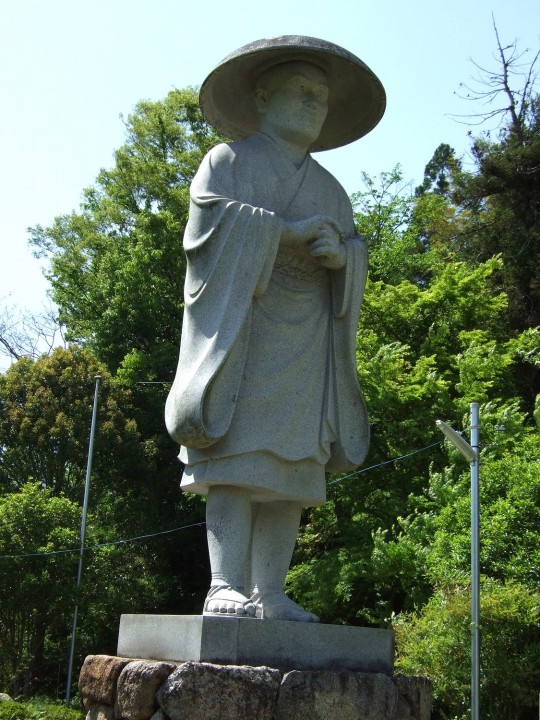
Ennin
Ennin (793-864, titre posthume: Jikaku Daishi) était un moine bouddhiste japonais de la secte Tendai qui étudia longuement le bouddhisme en Chine et en rapporta des connaissances sur les rituels ésotériques, les sutras et les reliques. À son retour, il publia son célèbre journal Nitto Guho Junrei Gyoki et devint l'abbé de l'important monastère d'Enryaku-ji, sur le mont Hiei près de Kyoto, et donc le chef de la secte Tendai.
Lire la suite...
1 note
·
View note
Photo

比叡山 滋賀の名所
比叡山(ひえいざん)は、滋賀県と京都府にまたがる日本屈指の霊峰で、古くから修験道の修行場として知られています。山上には多くの寺院があり、その歴史と美しい自然が訪れる人々を魅了しています。 1. 修験道の中心古来より修験道の聖地とされ、修験者が修行や山岳信仰を行ってきました。多くの修験道���や霊場が点在し、修験者の修行の場となっています。 2. 多くの寺院比叡山には多くの寺院が建ち並び、その中でも延暦寺(えんりゃくじ)は特に有名で、山上最大の寺院として知られています。 3. 豊かな自然山頂周辺には豊かな自然が広がり、四季折々の美しい景色が楽しめます。特に春の桜や秋の紅葉は見事です。 4. パワースポット古くから修行や信仰の場として崇められ、その神聖な雰囲気からパワースポットとしても訪れる人々に人気です。
♪♫♬🎤🎹🎶♪♫♬🎤🎹🎶♪♫♬🎤🎹🎶♪♫♬🎤🎹🎶
Mt. Hiei Famous places in Shiga
Mt. Hiei is one of Japan's most sacred mountains, straddling Shiga and Kyoto prefectures, and has long been known as a training ground for Shugendo. There are many temples on the mountain, and their history and beautiful nature attract visitors. 1. Center of ShugendoSince ancient times, it has been considered a sacred place for Shugendo, where Shugendo practitioners have practiced ascetic practices and worshiped the mountains. There are many Shugen dojos and sacred places scattered throughout the area, which serve as training grounds for Shugendo practitioners. 2. Many templesMt. Hiei is lined with many temples, and among them, Enryakuji is especially famous and is known as the largest temple on the mountain. 3. Rich NatureRich nature spreads around the mountaintop, and you can enjoy beautiful scenery in each season. The cherry blossoms in spring and the autumn leaves in autumn are especially spectacular. 4. Power spotIt has been revered as a place of training and worship since ancient times, and its sacred atmosphere makes it popular among visitors as a power spot.
0 notes